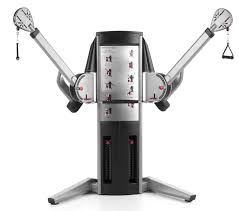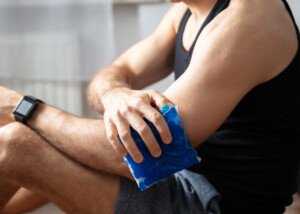Believe it or not, there are two ways to do inverted rows while protecting your golfer’s elbow from further injury or pain.
If you have golfer’s elbow, you can actually do sets of inverted rows.
I’m a former personal trainer who had golfer’s elbow. It hurt when I did the slightest gripping against resistance.
The medial epicondyle tendon of the elbow is what’s involved in gripping, and it is this structure that’s at the center of golfer’s elbow.
To spare this tendon any stimulation and allow it to heal, you must avoid gripping — at least with the index finger. More on that later.
Gripless Inverted Rows for Golfer’s Elbow
The first way is with a dual cable cross machine that provides a width adjustment.

Set the pins on a total weight that exceeds your body weight. Next, lower the cable arms to a height so that the strap-handles’ distance from the floor is about the same distance you would normally use a bar when doing standard inverted rows.
Set the width accordingly. If you normally do inverted rows with your heels on the floor, your equipment setup is completed.
If you normally elevate your feet, bring over a 12- or 18-inch workout stool if your gym has these.
Do not position it between the strap-handles and the machine; there won’t be enough room to extend your body and perform the inverted rows.
Instead place the stool (or chair, whatever you have), out away from the arms (hopefully there’s room).
Place heels on it and pretend you’re getting into position for the exercise to make sure the stool is the right distance from handles.
You will NOT be gripping the plastic handles. Instead you will be inserting both hands through them so that the strap portion tugs against the underside of both wrists.
If you have golfer’s elbow only on one side, you still must put BOTH hands in this position to ensure equality on both sides of your body.
Though this technique — straps digging into the wrists — sounds painful, it’s not. You will likely be able to do full-out inverted rows this way with minimal discomfort, if any at all.
The plastic part of the handle must NOT make contact with wrists; slide it off to the side, and only the strap portion makes contact with your skin.
You can slip your hands through while sitting up, then recline back into the start position; or, you can insert hands while maintaining a reclined position.
You’re now ready to begin reps. The handles should be high enough off the floor so that, when you’re at the bottom of the movement, your arms are nearly straight.
If you feel aggravation in the tendon, cease the activity. I can only speak for what has worked for me.
I advise against using a forward-palm grip, as this pronation may aggravate the tendon. First try a supinated (palms facing you) grip, then a neutral grip of palms facing each other.
Suspension Straps
This same technique can be done with suspension straps. It’s a matter of personal preference.
But I actually think it’s a whole lot easier with suspension straps. The reason I myself did not use suspension straps was because, at the time I had the golfer’s elbow, the gyms I was working out at did not have suspension straps set up.
They now do, however. This device will work superbly and does not require the set-up hassle as the dual cable equipment.
The problem is that many gyms don’t have these suspension straps. But if yours does, I recommend that you try the inverted rows on these first.
Gripping that Excludes the Index Finger
It’s possible that you can avoid the pain of golfer’s elbow by excluding the index finger from your gripping activities.
The medial epichondyle tendon controls flexion of the index finger against resistance, such as when gripping or using it to press down on a knife when cutting meat.
Try the inverted row without the index finger. If it still bothers the elbow, then exclude the thumb, so that you’re gripping the handle with only the middle, ring and pinky fingers.
This is very doable but will require a reduction in weight load from what you’d normally use with all five fingers and a healthy elbow.










































